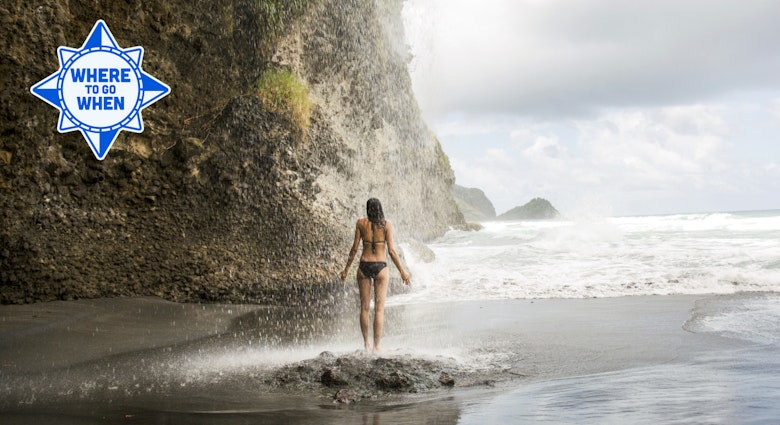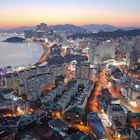
South Korea has an incredible range of experiences for a country of its size – an eclectic nightlife in the capital that never sleeps, trekking through the mountains followed by forest bathing, and a delicious and varied cuisine that will keep you coming back for more.
No matter what type of vacation you seek, this petite peninsula has something to delight everyone. Here are our favorite, can't-miss experiences in South Korea.
1. Watch the cherry trees blossom in Jinhae
In late March and early April, South Korea turns pink and white as millions of cherry trees billow with delicate blooms. While the blossoms can be seen all across the country, the most famous viewing spot is the small southern coastal district of Jinhae. With as many as 360,000 trees – some more than 100 years old – Jinhae's cherry blossom festival is the country's most extensive.
- placement: fullWidth
- path: articles/in-content-top
- possible size: [970, 250], [970, 90], [728, 90], [300, 250], [320, 50], [1, 1],
- targeting:
{ "url": "top-things-to-do-in-south-korea", "destination": "South-Korea", "continent": "Asia", "country": "South-Korea" }
Throughout the 10-day festival, visitors can admire the flowers at the old train station Gyeonghwa-yeok, marvel at them lit up at night at Yeojwacheon Stream and Romance Bridge, enjoy the opening ceremony and other performances, and then shop the street vendors at Jungwon Rotary. It's pure magic.
Planning tip: The festival is very popular, and visitors flock from across the world to view the cherry blossoms. Be prepared for large crowds, but don't worry – people are generally very courteous, and you'll get your turn to take some incredible pictures at key sights.
2. Stroll along the Cheong-gye-cheon in Seoul
On a warm, bright day in Seoul, there's nothing better than meandering along Cheong-gye-cheon, the almost 11km (6.8-mile) stream that flows east to west through the city's downtown. Along this Joseon-era waterway, which was once covered with a highway and later restored as part of an urban renewal project, walkers can stop at the stream's museum, enjoy art installations, watch a street performance or simply sit on the steps with a snack. Cheong-gye-cheon passes under 22 bridges before connecting with the Jungnangcheon tributary and eventually the Han River. Slow down and savor each step.

3. Do the cha cha
No, not dancing: drinking. In South Korea, cha refers to each successive round of revelry in a single night, and it's one of the most essential things to be familiar with when exploring Korean nightlife. Il cha, round one, is typically barbecue when diners enjoy somaek (soju plus maekju, or beer) with their samgyeopsal (pork belly) and other grilled meats. From there, you might head to a pub for round two, another bar for round three then a club for round four.
For those who have managed to make it through all of that, the last round of the night is usually noraebang (private karaoke room), where you can order more alcohol and snacks while selecting your favorite tunes to sing – put your Korean skills to the test with a K-pop hit or two. If you can manage to follow the words, that is.

4. Visit a jjimjilbang, a traditional Korean sauna
A central aspect of Korean culture is visiting the local jjimjilbang. Meaning "heated rooms" these traditional saunas are where Koreans unwind and engage in a host of health and beauty rituals. In some cases they are combined with hot springs where you can relax in thermally heated, mineral-rich waters.
- placement: fullWidth
- path: articles/in-content-middle
- possible size: [970, 250], [970, 90], [728, 90], [300, 250], [320, 50], [1, 1],
- targeting:
{ "url": "top-things-to-do-in-south-korea", "destination": "South-Korea", "continent": "Asia", "country": "South-Korea" }
Saunas are typically heated to between 50°C (122°F) and 90°C (194°F) and are really quite pleasant. As you lie on hemp mats (or sometimes salt or jade crystals), the heated stone gently warms your body. After about 15 to 20 minutes, you'll start to sweat. It's easy to fall asleep, but don't – or you'll risk dehydration. Similar to other spa cultures around the world, jjimjilbang adhere to specific etiquette, including the essential practice of thoroughly washing before entering the baths.
Relax after your sauna, in the jimjilbang common areas where you can play computer games, watch TV or simply snooze (in fact, at many jjimjilbang its possible to stay overnight). Cap off a good steam by drinking sikhye – a fermented sweet rice drink usually sold at jjimjilbang – and eating hard boiled eggs that have been steamed in the saunas.
5. Cheer for your favorite city or company at a baseball game
South Korea's most popular professional sport is baseball, and whether you're a fan or not, you're in for a good time at a Korean Baseball Organization (KBO) game. Owned by some of the country's biggest conglomerates, the KBO league's ten teams include many brand names you might recognize, like Gwangju's Kia Tigers, Daegu's Samsung Lions and Seoul's LG Twins, who won the 2023 league season.
Before cheering on your favorite city or company, learn the special fight songs and chants for each team, as well as the roster of its best-known players. But the best part of KBO games might be the concession-stand setup: fried chicken, pizza and other snacks are actually affordable, convenience stores like 7-Eleven are on site and sell beer at the standard price, and you're even allowed to bring in your own food and alcohol. Another reason to take yourself out to a ballgame.
Planning tip: The baseball season runs between April and October, and tickets for big games get snapped up quickly. To increase your changes at grabbing a ticket, head to the box office early. Weekday games are less likely to sell out.

6. Shop until you drop at traditional markets
South Korea's sijang (traditional markets) are a cacophony of vendors hawking their wares, shoppers shouting their orders, fish splashing around water-filled basins and kitchenware clanging together. Just when you think you've gotten your bearings, an old man on a bike rings his bell to let you know he needs to get through. By venturing into the country's busiest markets, you'll immerse yourself in the chaos of everyday Korean life as you shop for clothing, accessories, housewares, produce, food and more.
In Seoul, Namdaemun Market and Gwangjang Market are among the city's oldest and most popular, both perfect to find something to eat while you shop. In Busan, head to Gukje Market for its hundreds of stalls selling a staggering selection of items, from leather goods to Korean drums. For more traditional markets, try Dongmun Market in Jeju-do and Jungang Market in Daejeon.
7. Check out the cafe scene
An Instagrammer's dream, South Korea's cafe scene has a spot for every taste. Pet cafes feature live dogs, cats, raccoons, meerkats, kangaroos and any number of other creatures to keep you company while you sip your coffee. Other themes range from books and movies to flowers, 2D illusions, travel, vinyl and more: you name it, you'll find it here. Just be prepared for menu prices that might make your eyes water: it's not uncommon for a plain Americano to set you back a whopping ₩7000.
- placement: native
- path: articles/in-content-native
- possible size: [f, l],
- targeting:
{ "url": "top-things-to-do-in-south-korea", "destination": "South-Korea", "continent": "Asia", "country": "South-Korea" }

8. Go hiking with makgeolli and jeon
With 70% of the country covered in mountainous terrain, hiking is a beloved South Korean pastime and a culture unto itself. While on the trail, you're sure to see trekkers racing up the slopes decked out in the latest and greatest mountaineering gear. At the summit, you'll notice them sharing packed picnics of gimbap (seaweed-wrapped rice rolls) and other snacks.
After a hard day's hike, you'll spot them unwinding with a favorite mountain pairing: jeon (savory fried pancakes) and makgeolli (fermented rice wine). Join in the custom at one of South Korea's 22 national parks or, if you're in Jeju-do, along the island-encircling Olle Trail.
9. Gaze at the bamboo trees in Damyang
Bamboo patches can be found scattered all over the southern part of the country, and the largest such forest is located in Damyang in North Jeolla province. A 16-hectare (39.5 acres) stretch of verdant green, Juknokwon is known for its many scenic trails and also has an art gallery, culture village and nearby bamboo museum. While you're in the area, you can even try a scoop of bamboo ice cream.

10. Get your caffeine fix in Boseong
The green tea capital of South Korea, Boseong County in North Jeolla province is a stunning emerald expanse of terraced fields that produces more than 40% of the country's nokcha supply. Visit the 500-hectare (1235 acres) Daehan Dawon, the region's oldest and largest plantation, to meander the tea fields and surrounding cedar and juniper forests. There's also a green tea shop for buying souvenirs plus a green tea restaurant for tasting nokcha-enhanced variations of classic Korean dishes like bibimbap and naengmyeon (cold noodles). Next door is the Tea Museum of Korea, a can't-miss attraction for any tea connoisseur.
11. Dig into each city's signature dish
From Andong's jjimdak (soy-braised chicken) to Suwon's galbi (beef short ribs), a signature dish characterizes many South Korean cities, and many of them have a single alley filled with vendors preparing their own variations on the local recipe. In Uijeongbu, go to Budaejjigae Street near Jungang Station to sample a boiling pot of budae jjigae, a blend of Spam, canned beans, kimchi and instant noodles that was invented in the aftermath of the Korean War using leftover rations from American military bases – the name translates as "army base stew."
In Chuncheon, check out Dakgalbi Street to try the city's quintessential spicy stir-fried chicken. Carnivores in Jeju-do can't miss its special black pork, said to be more tender than the pink variety. The iconic bibimbap in Jeonju is unique because the rice is cooked in beef broth, then often served tartare-style topped with raw beef and egg yolk. When you visit South Korea, you'd best arrive hungry.
- placement: fullWidth
- path: articles/bottom
- possible size: [970, 250], [970, 90], [728, 90], [300, 250], [320, 50], [1, 1],
- targeting:
{ "url": "top-things-to-do-in-south-korea", "destination": "South-Korea", "continent": "Asia", "country": "South-Korea" }
Explore related stories





 ActivitiesLonely Planet's guide to visiting a Korean bathhouse for the first time
ActivitiesLonely Planet's guide to visiting a Korean bathhouse for the first timeJun 19, 2024 • 8 min read
 Beaches15 of the world's most stunning islands for every kind of traveler
Beaches15 of the world's most stunning islands for every kind of travelerNov 25, 2022 • 10 min read

 BeachesSouth Korea’s top beaches for sunrises, surfing, festivals and nightlife
BeachesSouth Korea’s top beaches for sunrises, surfing, festivals and nightlifeAug 15, 2022 • 9 min read



